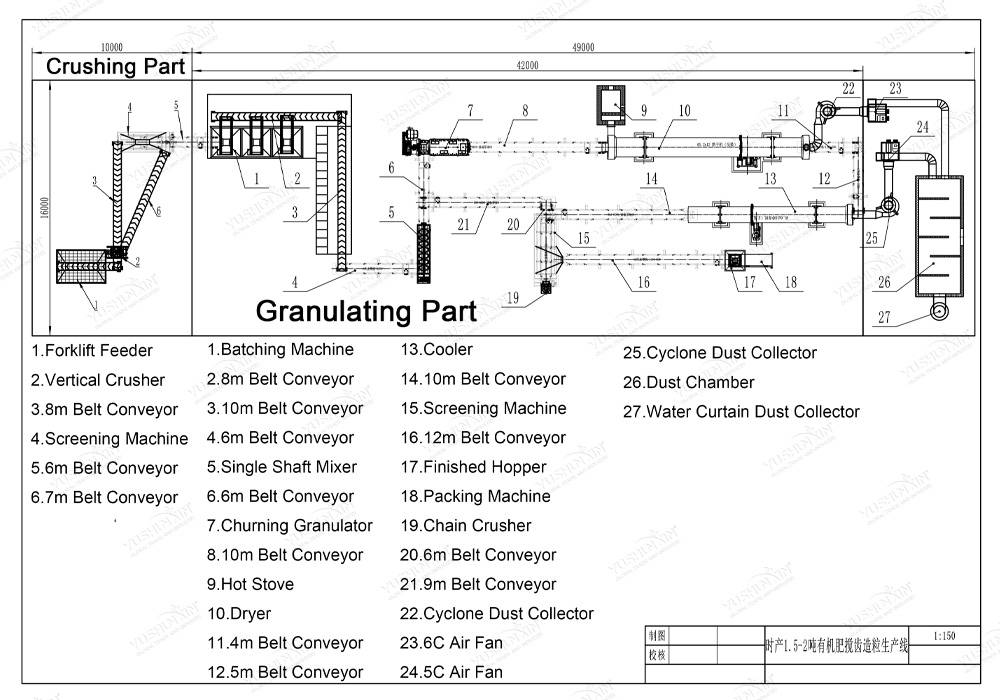

Sistemi di conservazione e alimentazione delle materie prime:
Attrezzatura di miscelazione:
Attrezzatura di granulazione (Se necessario):
Attrezzatura di asciugatura:
Attrezzatura di raffreddamento:
Attrezzatura di setacciatura e screening:
Attrezzatura di rivestimento (Opzionale):
Attrezzatura da imballaggio:

Nutrienti primari:
Nutrienti secondari:
Micronutrienti (Oligoelementi):
Agenti chelanti (per micronutrienti):
Acidulanti o regolatori di pH:
Additivi:
Materiali vettori (opzionale):
Il costo di ciascuna linea di produzione varia a seconda della capacità di produzione, grado di automazione, e esigenze specifiche. Compila il modulo sottostante e ti forniremo un preventivo accurato!
Se sei interessato alla nostra attrezzatura per la creazione di fertilizzanti, Invia i tuoi requisiti e contatti e quindi ti contatteremo tra due giorni. Promettiamo che tutte le tue informazioni non saranno trapelate a nessuno.
- La compagnia è stata fondata in 2005 e si è concentrato sulla ricerca, lo sviluppo e la produzione di attrezzature per fertilizzanti organici per 20 anni. Ha costruito una base di produzione di attrezzature per fertilizzanti biologiche su larga scala di 40.000 m, Utilizzo di granulazione avanzata, Tecnologie di asciugatura e screening per migliorare l'efficienza della produzione e la qualità del prodotto.
- Un'importazione di importazione ed esportazione autooperata con più di 80 Ingegneri professionisti in tutto il mondo, servire più di 100 paesi e regioni di tutto il mondo, 5,000+ Casi del servizio clienti, 10 Centri di elaborazione, 3 macchine da taglio laser, e più di 60 attrezzatura di vari tipi.
- Mantenere una cooperazione a lungo termine e ampia con molti istituti di ricerca scientifica e università, with a professional R&D team, Può ottimizzare continuamente le prestazioni delle apparecchiature in base alla domanda del mercato.
- Materiali resistenti all'usura ad alta resistenza, Carbon Steel Q235/Leghe sono selezionati per garantire che l'attrezzatura sia resistente e riduca i costi di manutenzione.
- Adottare sistemi di controllo intelligenti per migliorare il livello di automazione della produzione e ridurre la dipendenza manuale.
- Iso, Ce, Certificazione internazionale SGS
- Con capacità di produzione su larga scala, Può soddisfare diversi requisiti di capacità di produzione (piccolo, linee di produzione medio e grande).
- Una gamma completa di modelli di attrezzature, Adatto alla produzione di vari tipi di fertilizzanti come fertilizzanti organici, fertilizzante composto, fertilizzante biologico, fertilizzante idrico, fertilizzante liquido, ecc.
- Il design personalizzato può essere fornito in base alle esigenze dei clienti, compresa la capacità produttiva, layout del sito, Standard di protezione ambientale, ecc.
- Fornire un set completo di soluzioni di linea di produzione, compresa la selezione delle attrezzature, installazione e messa in servizio, formazione tecnica, ecc.

- Fornitura di fabbrica diretta, Ridurre il collegamento di intermediario, E il prezzo è più competitivo.
- L'attrezzatura ha un'elevata efficienza energetica, riduce il consumo di energia, e aiuta i clienti a ridurre i costi operativi a lungo termine.
- Fornitura di fabbrica diretta, Ridurre il collegamento di intermediario, E il prezzo è più competitivo.
- L'attrezzatura ha un'elevata efficienza energetica, riduce il consumo di energia, e aiuta i clienti a ridurre i costi operativi a lungo termine.
Consegna di successo di granulatori a doppio rullo da 1 T/H a clienti in Turchia e nel Regno Unito
Soluzione efficiente per la rivoltatura del compost consegnata a un cliente filippino
Aumentare l’efficienza della pellettizzazione per il gruppo GoodEarth, Sudafrica